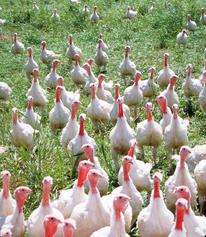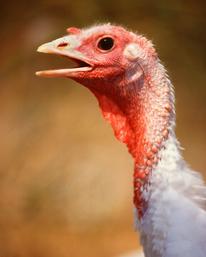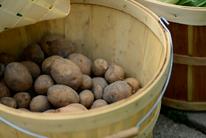By Michelle Miller
Edited by Kristine Moncada, Craig Sheaffer, Gigi DiGiacomo and Nicole Tautges
David and Dan grew up on the family farm in Fullerton, North Dakota, established by their parents in 1953. The farm was certified organic in 1977, decades before federal standards were implemented, and David and Dan, believing in organic production principles, continued to manage the land organically.
Currently, David and his wife Ginger manage small grains on most of the 480 acres. They grow triticale, hairy vetch, buckwheat, and millet. A diverse grain farm such as theirs has many integral components that include on-farm seed saving, cover crops, diverse rotations and green manures. For example, David has grown ‘Crown’ proso millet for more than six decades using the same seed. “We’ve been saving and planting it back, and it maintains its vigor and other qualities year to year,” David explains.
Theresa grew up on a conventional seed potato farm, completely unaware of organic agriculture. It was a college ecology course that changed how she thought about farming and introduced her to this alternative approach to agriculture. She married into the Podoll family and in 1984 started farming organically with her husband, Dan, as part of the family operation.
As a complement to the grain operation, Dan and Theresa developed a profitable organic turkey enterprise, raising upwards of six thousand birds each year. Dan and Theresa manage this part of the operation. It was a way to add value to the small grains business. They could “farm smarter, not bigger” through stacked enterprises.
The turkey operation benefited from high-quality feed grains produced on-farm. In turn, the turkeys produced manure, providing fertility back to the fields. They raised high-value, heritage turkeys that were profitable and in strong demand with primary markets on both the east and west coasts of the US. Despite their strong business, marketing and production skills, this farm enterprise, like all independent businesses operating in small to mid-size supply chains, was vulnerable to changes further down the supply chain. In the Podolls’ case, they were dependent on the regional poultry processing plant.
Processing Problems
Many states, including North Dakota, limit on-farm processing and direct sales to 1000 birds per year. On-farm processing handles a maximum of 50-100 birds per day. At this rate, it would take at least 60 days to process the Podolls’ turkey intended for Thanksgiving tables. A small-scale regional poultry plant like the plant that the Podolls relied upon usually processes around 200 birds per day, and up to 350 birds an hour. Regional plants typically process at least 50 days per year and tend to be independent or part of a grower cooperative.
In contrast, large poultry plants process year-round and daily as many as 250,000 birds per day. These plants are part of an integrated supply chain, where poultry production, processing and marketing are done by one company, so they wouldn’t serve a farm like the Podolls’. In 2017, poultry was highly consolidated, where more than 55% of the turkey consumed in the US was raised and processed by four companies.
The Podolls’ turkey business was nearly ten years old when, a few weeks before a barn-full of 6,000 turkeys were scheduled to be processed, the Podolls learned that the state was closing the processing plant. The plant had entered into contracts with local poultry farmers to raise chicken for them to process, was later unable to sell the chickens, and didn’t pay the farmers who raised them. State officials forced the plant’s closure because of the broken contracts with farmers and improper licensing. With considerable effort and stress, the Podolls were able to negotiate emergency processing services with a plant in Minnesota and fulfill their own marketing contracts that year.
The Minnesota plant was unwilling to provide services on an ongoing contract basis. Without assurance that they would have somewhere to process the birds, the couple needed to think outside the box. Dan and Theresa came up with a number of options, only some of which they were willing to entertain seriously.
The Podolls considered setting up their own processing plant. Consolidation in the poultry industry meant that there was a growing shortage of processing services for independent farmers. The closure of the only nearby plant meant that other farmers were also in need of processing. The downside of this option is the extensive cost of building a facility vs. return on their investment. It could cost as much as $500,000 to build a small plant, and then they would also need to contract with other poultry producers to keep the plant operating at capacity. It would shift the emphasis of their business from working on-farm raising turkeys to off-farm processing and marketing poultry.
Conversely, if they shifted the business to something smaller and switched to processing turkeys on-farm, they would need to scale the business to a sixth of its current size. The amount of work would be similar but a smaller operation would leave space unused on the farm. Most importantly, the profit margin for the business would be much less.
New Directions for the Operation
If Dan and Theresa quit turkey production, they could work with David and Ginger to expand the grain farm. Dan and Theresa knew the business but a larger land base would be required to support two families. That land would need to be purchased or rented, and if there wasn’t land immediately available near the home farm, they may need to figure out how to get equipment to the new fields. Also, they would need to find a market for the grain they fed to the turkeys and find another source of manure.
Another direction would be to keep their options open. One of them could take a job off-farm. If they could secure an off-farm job, it would buy them time to identify and develop another enterprise. The job market was tight, but creating a suitable job was also an option. It might not be easy to find employment related to sustainable agriculture, but such a job could help build their business in other ways. Dan and Theresa knew they didn’t want to leave farming altogether, but buying time could help them realize a longer-term goal.
Both Dan and Theresa enjoyed raising vegetables for home consumption and considered commercial vegetable production to be an alternative enterprise. There weren’t many farms supplying vegetables for local markets, and they were rather far from a major population center. Pivoting in this direction meant that they would need to develop infrastructure such as a packinghouse (or other processing), cold storage capacity, and wholesale clients for the business to be successful, requiring significant capital investments. They would also need to hire seasonal labor to handle weeding and harvest tasks.
A final option they considered was to build on the family’s experience in saving seed for both grains and garden vegetables. They struggled to find organic seed suitable for their home garden and were saving seeds for many of their favorite varieties already. The couple wondered if they could develop regionally adapted vegetable seeds that they could sell through existing organic seed companies. Such a business would allow them to continue to conduct on-farm research and plant variety improvement, but on a much larger scale. They could target seed production not likely to be addressed by land-grant universities, opening up a unique market for their products.
The Podolls are facing a difficult situation, but they have several options for the future. What should they choose to do, given the challenges and opportunities before them?
Access the complete decision case study with all educational materials (pdf) >>>
You may cite this publication as:
Miller, M.2017.Marketing Poultry without a Processor.A Decision Case Study in Principles for Transitioning to Organic Farming: e-Learning Materials and Decision Case Studies for Educators. K. Moncada, C. Sheaffer, G. DiGiacomo, and N. Tautges (Eds). University of Minnesota, St. Paul, MN.


